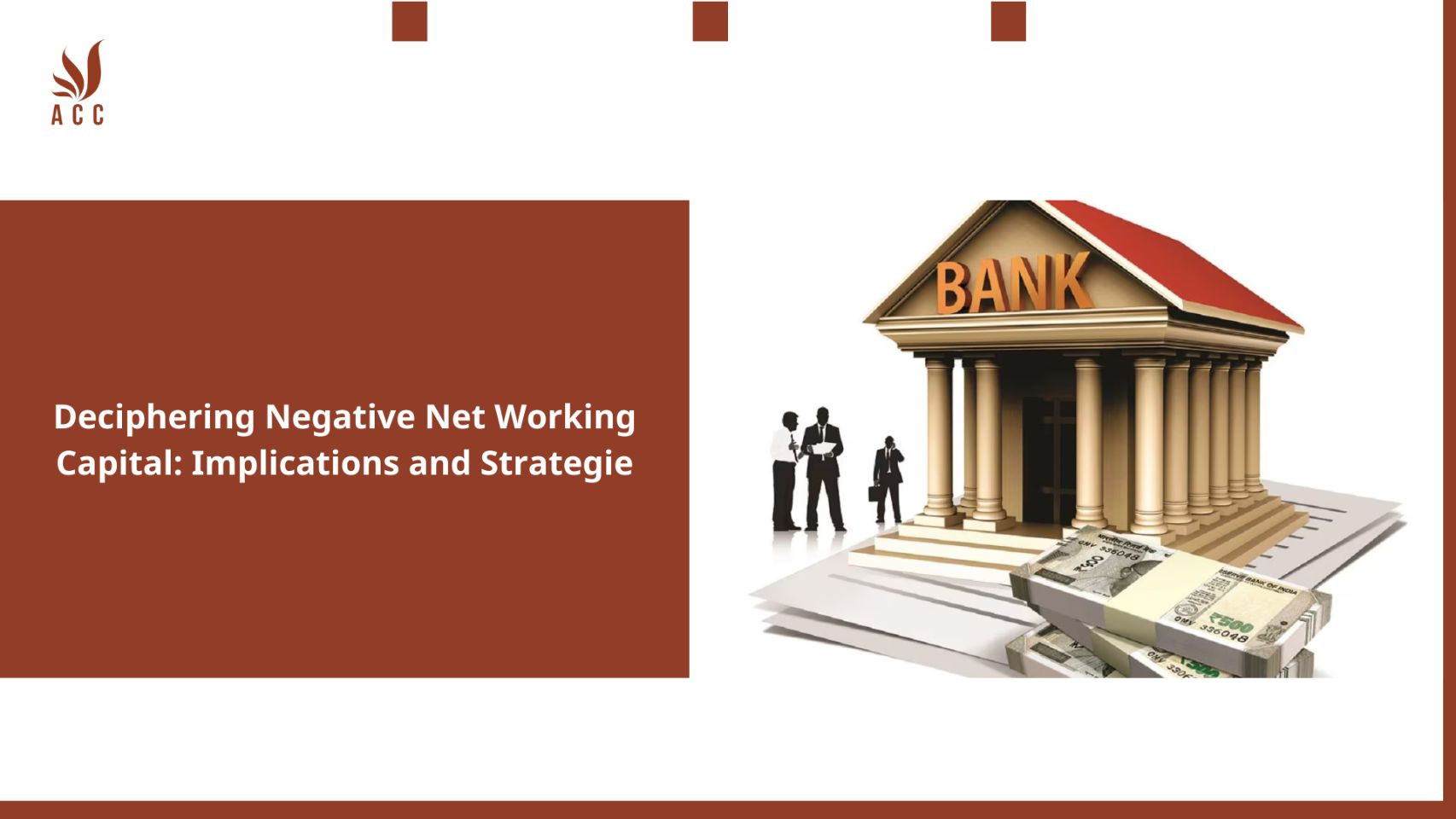
1. Deciphering Negative Net Working Capital: Implications and Strategie
In the fast-paced world of business, the notion of spending cash from customer sales before paying your suppliers might sound like a precarious financial maneuver. However, don't be too quick to dismiss the idea. Controlled periods of 'Negative Working Capital' can be a strategic approach to quickly generate cash and tighten your grip on your company's financial well-being. In this comprehensive article, we'll delve into the concept of Negative Working Capital, explore its advantages and disadvantages, and provide essential tips on how to manage it effectively within your organization. So, let's begin our journey into the world of financial strategy.
2. What is Negative Working Capital?
Negative Working Capital is a financial state where a business's current liabilities surpass its current income and assets. This temporary condition typically arises when a company makes substantial investments, such as expanding its inventory, launching new products, or acquiring equipment. While it may seem counterintuitive, Negative Working Capital can be a calculated risk that certain businesses take to spur growth and manage their finances more dynamically.
3. The Working Capital Cycle: Unraveling the Fundamentals
Before we explore the advantages and disadvantages of Negative Working Capital, let's gain a deeper understanding of the Working Capital Cycle. This cycle represents the time it takes to transform current assets into available cash. Mastering this cycle is vital for businesses as it allows them to maintain control over their cash flow and assess their financial agility effectively. The Working Capital Cycle consists of four crucial phases:
1. Ensuring Healthy Cash Flows
Sustaining a balanced inflow and outflow of cash is essential for financial stability.
2. Optimizing Receivables
Efficient management of customer payment terms helps in timely revenue collection.
3. Inventory Management
Monitoring the time it takes to sell your inventory is key to keeping cash circulating.
4. Managing Billing
Understanding your payment terms with suppliers is integral to managing your cash flow.
Tony Groom, a financial change advisor, emphasizes the significance of prudent financial management, especially when engaging in Negative Working Capital. Carefully assessing your expenses and the rationale behind them is crucial. Using cash reserves to settle debts, for instance, could exacerbate your Negative Working Capital situation, making it challenging to steer your business towards growth.
4. Deciphering the Negative Working Capital Cycle
A Negative Working Capital Cycle occurs when a business collects revenue more swiftly than it pays its bills. This means that a company can swiftly free up cash that would otherwise be tied up in the cycle, enabling it to allocate funds to other critical expenses like supplier bills and payroll without significant risk. However, it's essential for a business to have a firm grasp of its standard Working Capital Cycle to gauge whether it can afford to employ Negative Working Capital as a strategy.
5. Is Negative Working Capital Good or Bad?
Utilizing Negative Working Capital is a strategy often embraced by fast-growing, high-turnover companies that don't extend credit to their customers. Such businesses typically possess stringent inventory management, strong brand recognition, and robust negotiation skills with suppliers. Sam Walton, the founder of Walmart, is a prime example of an entrepreneur who successfully employed this strategy. By ordering large quantities of stock and selling it for profit well before the payment deadline, he freed up cash for further expansion.
6. The Pros and Cons of Negative Working Capital
Advantages of Negative Working Capital
One of the most significant advantages of Negative Working Capital is the ability to invest strategically in fueling rapid growth. For instance, Derek Greene, the Chief Executive of Track4Services, leveraged a period of Negative Working Capital to invest in upgrading one of the company's flagship products during a slow period of orders. This strategy allowed the company to maintain competitiveness and innovate when market conditions were volatile.
Disadvantages of Negative Working Capital
Companies operating with Negative Working Capital have limited room to seize opportunities for innovation, expansion, or acquisitions. It can also impede plans for business expansion, as investors may perceive Negative Working Capital as a sign of poor sales or unpaid customer invoices. Furthermore, a lack of readily available cash can leave a business vulnerable to unforeseen financial challenges, such as repairs, legal expenses, or economic downturns.
7. Identifying Industries with Negative Working Capital
Certain industries are more prone to Negative Working Capital due to their specific business models. Large food retailers, online and discount stores, fast-food restaurants, utilities, software companies, and telecom enterprises are often found in this category. As an example, grocery giant Sainsbury's rapidly converts stock into cash at its checkouts long before payment is due, effectively using suppliers' credit to finance its operations.
8. The Impact on Company Valuation
For SMEs with Negative Working Capital, potential investors typically seek rising revenues as an indicator of financial health. Falling revenues often suggest poor liquidity, indicating an inability to quickly convert assets into cash. Therefore, maintaining a positive working capital balance is essential for attracting investors and ensuring your business appears attractive and solvent.
9. How to Avoid Negative Working Capital
To sidestep the pitfalls of Negative Working Capital, proactive management of your working capital is critical. Start by setting your financial planning period and creating a comprehensive cash flow forecast. This will help identify potential shortfalls, payment issues, and areas where resources may be tied up in inventory for too long. Additionally, ensure that pricing and invoice decisions are aligned across your organization, preventing conflicts between the quest for quicker cash and longer credit terms.
In conclusion, effective working capital management is a delicate balancing act, especially as monthly bills come due. With the right strategies in place, you can not only avoid Negative Working Capital but also guarantee the sustainability and growth of your business. It's a tool that every successful enterprise should wield wisely to ensure financial stability and prosperity.
So, remember, Negative Working Capital is not merely a financial risk; it can be a calculated move that empowers your business to flourish in the competitive marketplace. By mastering the art of financial management and leveraging the Working Capital Cycle, you can take control of your business's destiny and secure a prosperous future.
10. Why should professionals use ACC Law Firm's capital Service?
-
Expertise in Legal Matters: ACC Law Firm specializes in legal services, providing professionals with access to experienced attorneys who can offer valuable legal guidance. Whether it's contract negotiations, intellectual property issues, employment matters, or any other legal concern, their expertise can be invaluable.
-
Tailored Legal Solutions: ACC Law Firm understands that every professional's needs are unique. They can customize their legal services to address the specific challenges and opportunities faced by professionals in different fields.
-
Risk Mitigation: Legal issues can pose significant risks to professionals and their businesses. ACC Law Firm can help identify and mitigate these risks, reducing the potential for costly legal disputes or compliance issues.
-
Resource Optimization: Professionals can save time and resources by outsourcing their legal needs to ACC Law Firm. This allows them to focus on their core competencies and business objectives, while leaving legal matters in the hands of professionals.
-
Access to a Network: ACC Law Firm may have a network of legal experts and professionals in various fields, which can be beneficial for clients seeking connections and advice beyond just legal services.
Q&A
Question 1: What is negative net working capital, and what does it indicate about a company's financial health?
Answer 1: Negative net working capital occurs when a company's short-term liabilities exceed its short-term assets. This situation suggests that the company may have difficulty meeting its current financial obligations and may be relying on short-term borrowing to cover operational expenses.
Question 2: What are some common reasons for a company to have negative net working capital?
Answer 2: There are several reasons for a company to have negative net working capital, including:
- Rapid business growth, leading to increased accounts receivable and inventory.
- Seasonal fluctuations in cash flow.
- Poor management of accounts payable.
- Aggressive expansion strategies.
- Economic downturns affecting revenue.
Question 3: Is negative net working capital always a sign of financial distress?
Answer 3: Negative net working capital is not necessarily a sign of financial distress, but it does warrant attention. In some cases, companies with negative working capital can still manage their short-term obligations effectively, particularly if they have access to external financing or if they are in a high-growth phase. However, sustained negative working capital can be a cause for concern if it leads to liquidity problems.
Question 4: How can a company address negative net working capital and improve its financial position?
Answer 4: To address negative net working capital, a company can take various measures, including:
- Increasing sales and revenue.
- Reducing accounts receivable by improving collection practices.
- Managing inventory more efficiently.
- Negotiating extended payment terms with suppliers.
- Securing short-term loans or lines of credit to bridge funding gaps.
Nội dung bài viết:






Bình luận